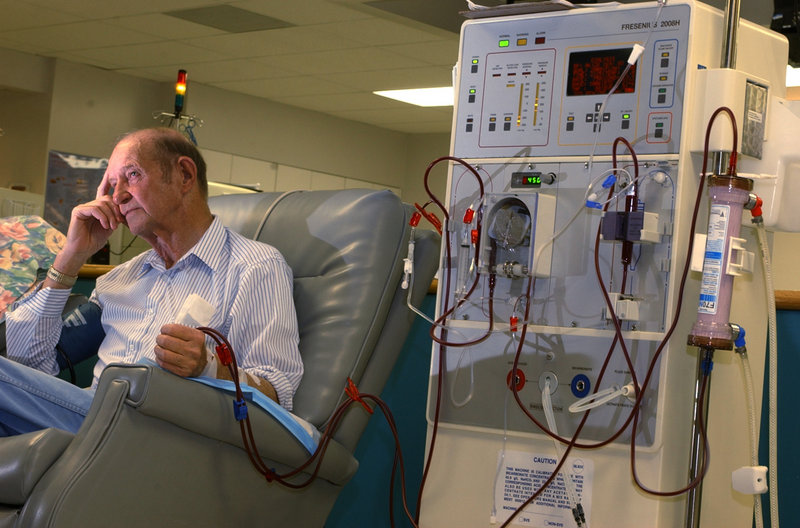LOS ANGELES – A major study challenges the way diabetics and others with failing kidneys have been treated for half a century, finding that three-times-a-week dialysis to cleanse the blood of toxins may not be enough.
Deaths, heart attacks and hospitalizations were much higher on the day after the two-day interval between treatments each week than at other times, the federally funded study found.
The president of the National Kidney Foundation said she was “very troubled” by the results published in today’s New England Journal of Medicine.
“We could be doing a better job for our dialysis patients” and that might mean doing it more often, said Dr. Lynda Szczech, a Duke University kidney specialist who had no role in the study.
Kidneys rid the body of waste and fluids. Most of the 400,000 Americans with failing kidneys stay alive by getting their blood purified by a machine three days a week at dialysis clinics — usually on Mondays, Wednesdays and Fridays or on Tuesdays, Thursdays and Saturdays. In both cases, there’s a two-day break between the last session of the week and the next one.
The three-day dialysis schedule has been around since the mid-1960s and gives patients a weekend break from the grueling hours of being hooked up to a machine.
However, doctors have suspected that the two-day hiatus between treatments was risky, and smaller studies have found more heart-related deaths on the day after the gap.
“All the fluids and toxins are built up to the highest extent on Monday morning right before dialysis,” said Dr. Anthony Bleyer of Wake Forest Baptist Medical Center in North Carolina, who has done similar studies.
The latest research, funded by the National Institutes of Health, is the largest yet. It was done by Dr. Robert Foley of the University of Minnesota and colleagues. All reported receiving fees from dialysis clinics and suppliers.
The team analyzed medical records of 32,000 people who had in-center dialysis three times a week from 2005 through 2008. The average age was 62 and a quarter and had been on dialysis for a year or less. After about two years of follow-up, 41 percent had died, including 17 percent from heart-related causes.
Monday was the riskiest day for people on a Monday-Wednesday-Friday schedule. For those on a Tuesday-Thursday-Saturday schedule, the riskiest day was Tuesday.
Researchers found a 22 percent higher risk of death on the day after a long break compared with other days of the week. Put another way: For every 100 people on dialysis for a year, 22 would die on the day after the long interval versus 18 on other days.
Hospital admissions for stroke and heart-related problems more than doubled on the day after a long break than on other days — 44 versus 20 for every 100 people treated.
Fixing this problem, however, could be daunting for patients, busy dialysis centers and insurers and it would require a rethinking of how dialysis is currently delivered.
Medicare covers thrice-weekly treatment, about $77,000 annually per person. But people can get a fourth session if needed.
Send questions/comments to the editors.



Success. Please wait for the page to reload. If the page does not reload within 5 seconds, please refresh the page.
Enter your email and password to access comments.
Hi, to comment on stories you must . This profile is in addition to your subscription and website login.
Already have a commenting profile? .
Invalid username/password.
Please check your email to confirm and complete your registration.
Only subscribers are eligible to post comments. Please subscribe or login first for digital access. Here’s why.
Use the form below to reset your password. When you've submitted your account email, we will send an email with a reset code.